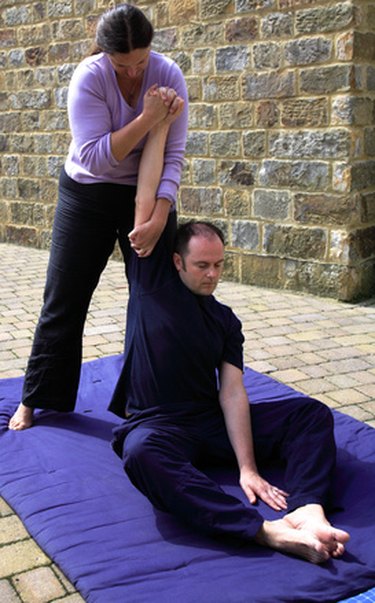
A joint's range of motion is the angle through which a joint moves from the anatomical position to the extreme limit of the motion in a particular direction. Having an optimal range of motion allows you to move freely without pain or stiffness and perform activities and work without injuries.
Joint Articulation
Video of the Day
Joint articulation refers to how the bones, tendons, ligaments and muscles are oriented in a joint to permit certain range of motions. Some articulations provide only one range of motion, such as the elbow joint, where it allows only the arm to flex or extend. Others allow a wide variety of movements, such as the ball-and-socket joint of the shoulder, where it can flex, abduct, adduct and rotate.
Video of the Day
Muscle or Fat Mass
Extra fat or muscle mass may inhibit a joint's normal range of motion by physically blocking its path of movement. For example, a protruding abdomen can limit how high you can flex your hip and pull your knee to your ribs.
Body Asymmetry
People who play asymmetrical sports, like tennis and baseball, are likely to have less range of motion in the dominant shoulder or hip than the nondominant side, although the dominant side may have more coordination, strength and stability than the other side. This also applies to other daily activities, such as sweeping, vacuuming, writing and carrying a purse.
Injury and Disease
Pain from an injury or disease causes the muscles in the injured site to contract reflexively to avoid further damage, thus limiting the joint's range of motion. Such conditions include arthritis, bursitis, bruises, dislocation and sprains. Regular range of motion can be achieved over time with proper rehabilitation and treatments, such as corrective exercises, massage, heat therapy and acupuncture.
Tissue Extensibility
Tissue extensibility refers to the elasticity and flexibility of the muscles and their surrounding connective tissues. If they are not stretched or moved regularly, they can become stiff and lack extensibility, which affects how much you can move.
In practical application, before exercise, you should perform warm-up exercises that move your joints in its full range of motion. For example, before you run, you can do hip swings in the sagittal plane (front to back), frontal plane (side to side) and transverse plane (rotation). This exercise not only elevates your body temperature to improve tissue extensibility, but also moves the hip joint in all plane to motion to minimize stiffness and increase neural stimulation.
Is this an emergency? If you are experiencing serious medical symptoms, please see the National Library of Medicine’s list of signs you need emergency medical attention or call 911.